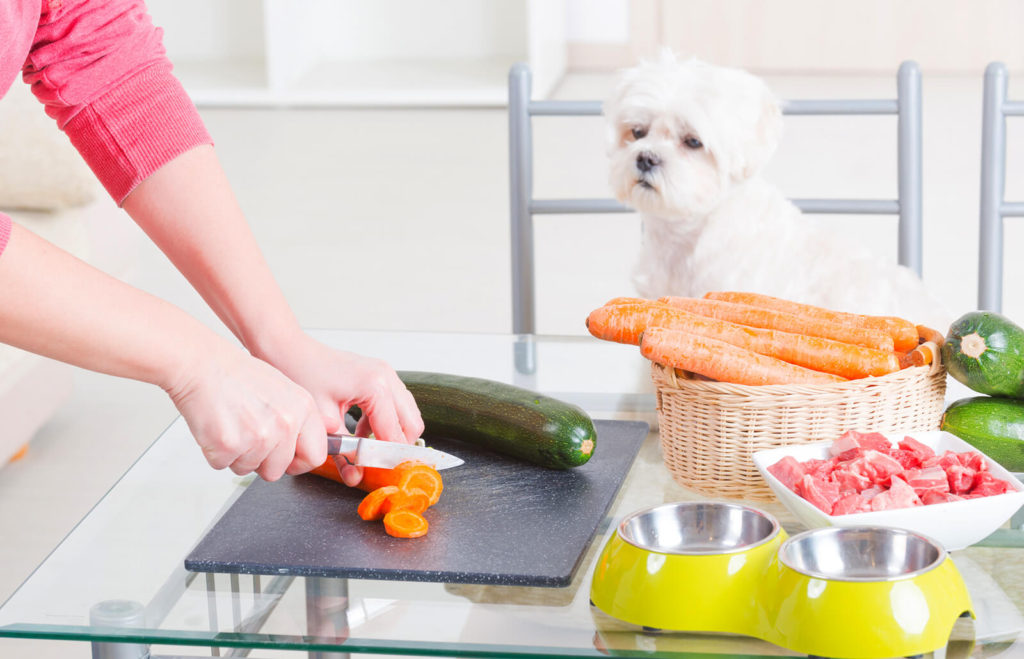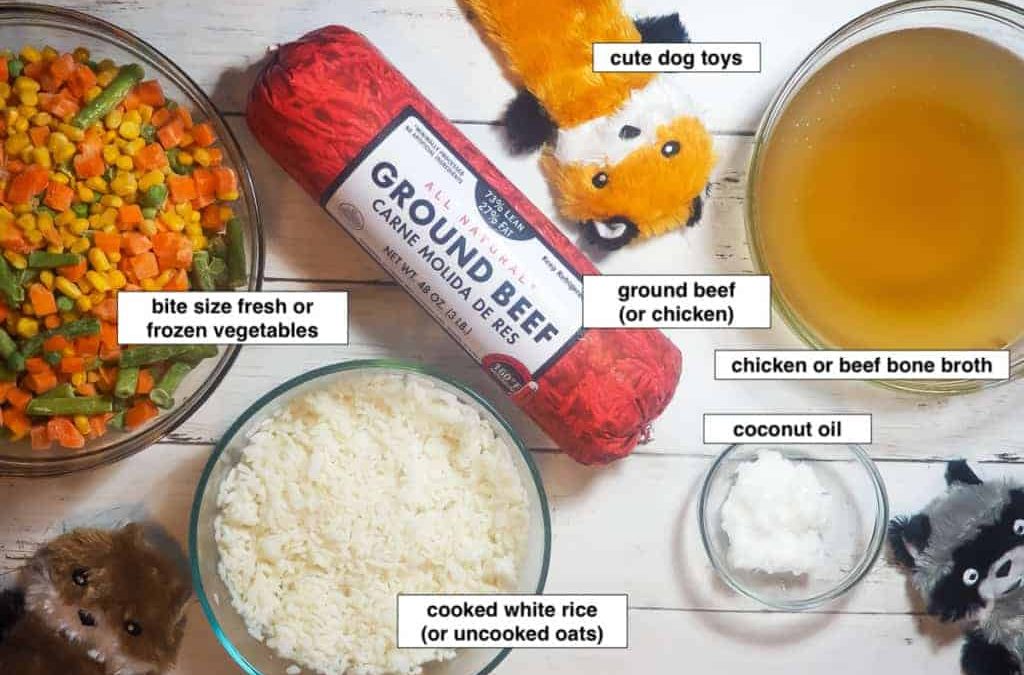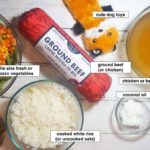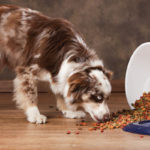How to make homemade dog food – Owning a dog is both an enriching and enthralling experience. This feat comes with many responsibilities, chief of which include grooming, feeding, and figuring out the entire basics of dog nutrition. Unlike the majority of humans with iron-clad stomachs, dog has easily-irritated stomach and so setting up a complete and balanced diet plan that works for your hound seems quite a daunting task most of the time.
One might think that commercial dog food brands solve this gap in nutrition, but adopting commercial dog food often adds to the problem instead of solving or reducing it. The undying controversy around commercial dog food brands and the ingredients they contain confirm this. While most people criticize them for their use of harmful substances and low-quality ingredients in their recipes, other totally boycott some brands because of their use of allergenic food sources, artificial additives, and imbalanced attributes.
These claims around commercial foods often make them unreliable choices and so leaves dog parents with the option of personalizing diets that suit their hound’s dietary habits and are formulated with whole and healthy ingredients they trust. Homemade food can either be cooked or raw, depending on the nutritional goal the dog parent wants to achieve, the digestive health of the dog, and the dog’s breed and size. In addition, homemade dog foods are balanced and complete seeing that it takes necessary factors like breed, physical activity, age, and weight, into consideration during its preparation process.
However, most dog owners are wary of homemade dog foods because of its associated downsides. With this category of food, there is a constant possibility of bacterial contamination and the inclusion of common allergenic items. The surest way to bridge both gaps identified in both commercial and home-made dog food categories is often to combine both food types so to get a diverse and balanced proportion of nutrients contained in both, and to eliminate further possibilities of food contamination and food intolerances. It is also important to note that the more diverse a dog food is, the better suited it is.
Moreover, homemade dog food remains an ideal and popular choice whenever it is compared to majority of commercial dog recipes readily available at pet stores because of its many nutritious prospects and the overall control it grants dog owners over what their dog eats. Also, homemade dog foods are perfect for hounds with skin diseases, gastrointestinal upsets, and food intolerances.
Reasons For Adopting Homemade Dog Foods
NUTRITION SAKE: unlike most loosely regulated commercial dog foods, homemade dog foods are formulated with the best ingredients and with enough care. Often with adequate knowledge of the dog’s digestive system and feeding habits, home-made foods are tailored to fit the desired nutritional needs. Also, home-made dog food offer diverse nutrition unlike commercial dog foods that offers the same nutritional benefits all the time. Moreover, incorporating nutritionally-diverse meals increases the food’s appeal and makes for optimum nutrition all the time.
In addition, commercial dog foods are often formulated with artificial additives like preservatives, hormones, fillers, and colours. This additives are often added to increase shelf-life and palatability of the product even though they often have adverse effects on dogs. The most common of these preservatives commonly found in commercial dog foods is ethoxyquin, which is a very harmful pesticide that can cause darker urine, pale gums, liver cell death, etc. others include carcinogens like butylated hydroxytoluene and hydroxyanisole.
Also, preparing your own dog food places your dog’s nutrition entirely into your hands and affords you the opportunity to control what they eat. This makes it easier to tackle a food intolerance or allergy when such arises. They are also ideal for dogs with food allergies and gastrointestinal options.
EXCESS TIME: if you have excess time on your hands, it could be the best reason to adopt homemade dog food, with reference to its great nutritional benefits. Contrary to popular assumption, home-made dog foods are the opposite of time-consuming especially when you make plans ahead of the preparation proper. Just liking planning a baking session, making plans for home-made dog food preparation includes sourcing for your ingredients, locally processing the food items that need processing, and carefully preserving the perishable ones. Doing these cuts down the process and makes it very easy to proceed.
In addition, there are a couple of kitchen appliances like blender, digital scale, electric cookers, oven, food processors, and refrigerator that make the preparation process easy and efficient.
COST-EFFICIENT: if you are after wholesome and budget friendly nutrition, then there is enough reason to consider home-made meals for your hound. This is because there are many ways to save cost with food items like buying such items directly from local groceries markets, sourcing for meat crumbs and discounted bits from local butchers, or simply harvesting from the garden in the backyard. Also, crumbs from the kitchen and leftovers are great ways of cutting down overall cost.
EASY AND CONVENIENT: whether you love to cook or not, home-made dog foods are convenient options since the process allows preparing the food in bulk and having some parts well-preserved and saved for later. Also, they can be transported and taken along while travelling or camping as long they are properly sealed and preserved. When stored in a freezer, they can stay fresh and palatable for as long as intended.
Ingredients To Use In Home-Made Dog Foods

There are many easily accessible food items that can be incorporated into home-made dog foods. Some of these ingredients may either be cooked or raw depending on the diet plan. They include:
Muscle meat. Especially lean and skinless chicken or turkey, rabbit, lamb and other high-quality sources of amino acids. The lean attribute attached to these protein sources and the removed skins reduce the fat content.
Fish (especially tuna and salmon) is an essential source of vitamin D. They can be fresh or come canned and packed in water (but never oil).
Liver, offal, and meaty bones, raw (the liver part should be a once-in-a-while feature so as to avoid the bulk of vitamin toxicity)
Eggs, either raw or cooked (raw eggs might not be ideal for all dogs. First there is the threat of bacterial poisoning, and shortage of biotin. Whichever form, the quantity of eggs should be kept minimal).
Vegetables, either raw or cooked, like carrots, spinach, broccoli, peas, asparagus, cauliflower, cucumbers, lettuce, squash, etc. contrary to popular assumption, vegetables support digestive functions and contain essential antioxidants that improve immunity and overall good health. However, their quantity should be kept minimal.
Oils like cod liver oil, plants oil, fish oil, etc.
Ingredients To Avoid In Home-Made Dog Foods
While formulating your own dog food, it is very necessary to know that not all food items are meant for dogs to eat. Even though dogs are omnivores like humans, it is never advised to feed them with everything humans eat. Some food items consumed by humans are very lethargic to dogs and so should be cautiously avoided. These food items include:
- Fast food
- Coffee
- Raw Yeast Dough
- Avocadoes
- Spice (like pepper, onions, garlic, curry etc)
- Chocolate
- Walnuts
Limited Ingredients In Home-Made Dog Foods
The limited nature of these ingredients means that they are either needed in smaller portions or just beneficial but not really necessary ingredients. This means that dogs can totally do without them and still live hale and hearty. An excessive amount of these substance is often nutritionally detrimental to dogs. These limited ingredients include:
- Milk and other dairy products
- Plain yoghurt
- Corn
- Cottage and ricotta cheese
- Egg plant
- Tomatoes
- Fruits (with the exception of grapes and raisins and the fruit portions should be kept small to avoid diarrhoea).
- Butter
- Sweet potato
- Mushrooms
- Cooking oil
- Celery
- Green beans
NB: even though grains are beneficial food sources, they are not really essential ingredients in home-made dog foods especially with regards to making these diets balanced and wholesome for dogs. On the other hand, beans and legumes are sources of plant protein and so should be included over grains. However, they should not constitute the whole diet as meat protein sources are always more beneficial and preferred over plant protein sources.
Some Tips And Guidelines To Follow While Making Home-Made Dog Foods
- Detailed planning and research is a primary and essential step in making homemade dog foods. The research should be informed by the knowledge of your dog’s nutritional needs, their tolerance threshold, and their physiology. On the other hand, the planning should cover healthy homemade dog food recipes, where to get or to source the freshest and most budget-friendly food items, and the required food rations and feeding schedule. It is crucial to involve your veterinary nutritionist before planning and researching. This is because they are more qualified and certified on dog nutrition and health than you are, and so their recommendations and suggestions would be a great point to start off from. Even after thorough planning and subsequent, your veterinarian still needs to review your homemade food plan. This means that all your food recipes must be approved by your veterinary nutritionist.
- While planning, you should make sure that the recipes include a wide range of foods from different classes of food that are rich in various nutrients. It is necessary to know that the more nutritionally- diverse your recipes are, the more nutrients they remit when consumed by your dog. Every good recipe must include foods that contain protein, fats, essential fatty acids, carbohydrate, vitamins, minerals, and water.
- Every homemade dog food should always emphasise variation, and at such should contain a healthy proportion of meat, vegetables, fruits, wholesome grains, and dietary fibers. This means that no individual food type, should constitute more than half of what the diet contains. The highest constituting ingredient should be meat and other related animal food sources, and they should only constitute half of the diet and not more. Proportional and balanced is the constant keyword here.
- Ingredients used should be fresh and wholesome. Food items like fruits and vegetables are better when they are fresh because most of the nutrients they contain are still intact at this point. In addition, buying fresh fruits and vegetables is more economical that the canned variant. You only need to store them properly to last longer.
- Even though it is expensive and physically draining to make your dog’s food yourself, buying food items in bulk can help reduce cost and make cooking for your dog an economical option. Also, buying meat craps and bones from neighbourhood butchers and local meat markets can help offset cost. These food items bought in bulk can also be preserved in a refrigerator or freezer to avoid spoilage. In addition, leftover foods and crumbs from the chicken can be incorporated into homemade dog foods. However, it is necessary to ensure that they do not contain substances that are detrimental to dogs like pepper, butter, salt, and others.
- It is advised that dog owners include real meat bones (which are real sources of protein) in the food composition. And if the food mix is prepared without meaty bones, it is necessary that dog owners add calcium supplements or crushed egg shells.
- Not minding the fact that dogs are omnivores like just humans, they however do not need human food seasonings like salt, pepper, garlic, and ginger in their foods. The digestive system of dogs is not the same as that of humans.
- Also, you can include dietary supplements that contain vitamins A, calcium, and essential fatty acids while formulating your dog’s diet. However, these supplements should be either recommended or approved by the vet.
Some Common Misconceptions About Homemade Dog Foods
Grains are harmful to dogs and should be excluded from their diet
Unlike what most grain-free dog food brands would have you believe about grains as low-quality fillers that are also allergenic, grains are very nutritious ingredients and whole sources of essential fatty acids and amino acids that improve coat and immune health. However, they should be incorporated into dog diets in smaller quantities and never as main ingredients.
In addition, to increase the digestibility and absorption rate of grains they have to be well-cooked. This is because the digestive system of dogs are not suited for digesting grains in their raw form. Also, some grains contain starchy carbohydrates and dietary proteins. However, once a dog has shown sign of being allergic to grains, it is advised that grains be completely eliminated from their diet. Grains are beneficial in small quantities but might not be nutritionally beneficial to all dogs because of its high carbohydrate content and allergenic tendencies.
Home-made recipes should contain only meat
Not minding the fact that dog still retain their ancestral carnivorous taste buds and have a special love for meat, they are evolved omnivores too. It is quite the ideal practice to integrate more meat in their food composition, but the meat should not be the bulk of the whole food. This is because dogs in addition to protein require other essential nutrients for growth, development, and sustenance. And so feeding meat-only diets will prove nutritionally-deficient.
Dogs Cannot Digest and Absorb Dairy Products and By-products
Diary or milk products include all foods that are produced or come from milk. And dogs like other omnivores can be lactose-intolerant, but this does not mean that all dogs react adversely to dairy products. The trick here is simple, the higher lactose content a dairy product contains the more difficult it is to digest. With this said, it is essential to reiterate that foods with lower and medium lactose content are perfectly safe for dogs, depending on breed and size. Plan yoghurt and kefir are well-liked and mildly tolerated by most dogs, along with ricotta and cottage cheese.
Addition of Supplements to Home-made Dog Foods Covers up the Nutritional Gaps
Many believe that supplements like digestive enzymes, probiotics, vitamin supplements and other nutritional blends balance out nutritional deficiencies. Supplements like the name implies are solely meant to augment and not replace the essential nutrients you dog needs to perform biological functions. It is advised you serve your hound meals that are balanced and complete without relying on supplements. Dog meals that contain wholesome nutrients are more biologically beneficial that those spiked with supplements.
Homemade Raw Foods are Nutritionally-Superior to Cooked Foods
Even though raw foods attempt to mimic the ancestral diet of pre-evolved dogs, it is however not for all dogs. Raw foods also known as biologically appropriate raw foods (BARF) are often preferred by active or working dogs because of its zero processing, balanced nutrition and high protein levels but they also have many downsides. Raw dog foods are more prone to biological contamination than the cooked version, can cause teeth breakage, and can damage the digestive tract. Also, raw foods are not ideal choices for dogs with food allergies and intolerances.
Adding enough yoghurt makes up for calcium loss
For dogs, calcium is an essential nutrient need for growth and the performance of day-to-day functions, and so the need for high levels of calcium. However, feeding them yoghurt alone would not meet their daily requirements. Instead, feeding them more yogurt may lead to stomach upset or gastrointestinal stress. Instead, you can incorporate raw bones, crushed egg shells, or calcium supplements.
Home-made Dog Foods eliminate all Food Allergies
Believing that home-made dog foods eliminate all food allergies experienced by dogs is a huge misconception. Feeding dogs with home-made dog meals may be more nutritionally rewarding but it does not get rid of allergens, bacteria and the risk of possible contamination.
Homemade foods might reduce it but it is still better to remember that food allergies can be caused by a wide range of factors, ranging from the presence of allergenic food items to environmental conditions. Extra care should be paid to the symptoms of a dog’s allergies in order to properly identify and tackle its source. Involving a veterinarian with enough knowledge of dog nutrition will also be a good idea.
Raw Eggs are Bad for Dogs
Even though your vet will likely suggest you firsthand consider the immune health of your dog before feeding them raw eggs, raw eggs are not entirely bad for dogs. With reference to structure and functionality, a dog’s digestive is shorter than that of most omnivores and by that virtue is more resistant to bacterial attack. Also, the egg yolk has a higher level of biotin than most food sources.
However, it is advised you feed them cooked eggs instead of raw ones. Boiling the egg does not in any way reduce the nutrient value but rather makes it highly-digestible.
Dogs do not need carbohydrates
Contrary to this misconception, dogs need carbohydrates just only not in higher quantity. Even though there is no known carbohydrate deficiency in dogs, they still need starchy carbohydrates for energy and to help regulate gastrointestinal activities.
Some Vet-Approved Home-Made Dog Food Recipes
Even though cooking your dog food yourself extends beyond mixing a couple of meat bits, fruits and vegetables, and essential fats, coming up with your own home-made dog food recipes should not be mentally draining or difficult. To get started easy, you can simply consult a veterinary nutritionist for healthy recipes. Furthermore, there are a couple of vet-approved home-made dog food recipes online if you really know here to look. You can start off with visiting some reliable dog nutrition blogs. You can also buy books on dog nutrition. A book like Feed Your Best Friend Better: Easy, Nutritious Meals and Treats for Dogs is a nice place to start. When adopting recipes, it is important to consider vital options like breed, physical activity, weight, and general health.
On recipe measurement, it recommended you stick to what the recipe says. However, the recipes can be customized to suit your dog’s specific needs especially if you know what you are doing. And if you do not, it is always better to ask a veterinarian you trust for help and guidance. You can also double the measures to increase the quantity of food.
The basic summary of every recipe should be:
- 45-50% meat based protein with little fat
- 30% fruits, vegetables and dietary fibers
- 5-10% carbohydrates
- 10% Essential fatty acids
NB: Calcium is an essential addition. Also, these nutrients proportions are not set and can be adjusted by choice depending on the dog’s breed, size, and dietary needs.
ALSO SEE: How To Store Dog Food of All Kinds Effectively
Meat Based Recipes
Chicken/Turkey Gourmet for Active Dogs
Duration: 40 minutes
Ingredients to Use:
- Chicken or turkey (1 pound)
- Brown rice (4 cups)
- Veggies (broccoli, sweet potato, carrots)
- Coconut oil (3 tablespoons)
- Salt
- Multivitamin of choice
How to Prepare
Pour the coconut oil into a pan and allow it to slightly heat. Slice the chicken into chewable bits and pour into the hot oil. Fry for a bit and allow to cool.
On the side, boil the rice and steam the veggies. Then pour the rice and veggies into the fried chicken bits and allow to heat for a while.
Stir until all the contents are properly mixed, then add a bit of salt and your chosen multivitamin. The salt quantity should be minimal as salt consumption is not good for dogs. The food can be shared into portion and stored in the refrigerator for future consumption.
Beef and Veggie Rich Mix
Duration: 30 minutes
Ingredients to Use
- Real beef, turkey, veal, and chicken (450g)
- Oat meal
- Potatoes (1 medium-sized piece)
- Fine ground barley (½ -1 cup)
- Carrots (one piece)
- Chopped green veggies including green peas, broccoli, and spinach (½ cup)
- Olive oil (3 tablespoons)
- Garlic (4 cloves)
How to Prepare
Cut the meat into chewable bits and fry in pre-heated olive oil for a while to melt down the fat.
Cut the potatoes and veggies into smaller bits and shred the carrot.
Then boil the barley, potatoes and oatmeal separately. Gently steam the carrot and veggies by the side. Simply pouring hot water and covering for some minutes will do the trick.
Then mix all items properly. The food can be shared into rations and stored in the freezer to retain its freshness.
Home-made Beef Stew
Duration: 40 minutes
Ingredients to Use
- Beef stew meat (1 lb)
- Sweet potato (1 small-sized piece)
- Diced Carrots (1/2 cup)
- Diced green beans (1/2 cup)
- Olive oil (1 tablespoon)
- Flour (1/2 cup)
- Water (1/2 cup)
How to Prepare
Cook the sweet potato for 4 to 7 minutes until it is soft. Then slice the meat into smaller chewable bits and cook in a tablespoon of olive oil over low heat until it is well-cooked. Set aside.
Set the dripping from the beef on a medium-heat fire, then cook and gently pour water and flour into the mix. Turn consistently until it turns into a marsh.
Then add the sliced meat, diced potato, carrots and veggies and stir consistently to thicken. Cook for some minutes until the newly added items are tender.
Let it cool and then serve. It can also be shared into portions and stored in the freezer.
Delicious Rabbit/Lamb Stew
Duration: 40 minutes
Ingredients:
- Lamb or rabbit (minced/ground)
- Peeled rice- 1 cup
- Fat-free yoghurt (½ cup)
- Olive oil- 1 tablespoon
- Carrot (grated) ½ cup
- Water (2 cups)
How to Prepare
Boil the rice until tender. Then cook the carrot on medium heat until it is tender. Then fry the minced or ground lamb or rabbit meat on medium heat. When tender, bring down and allow to cool.
Then mix everything properly while adding a little bit of water to get a gravy consistency.











